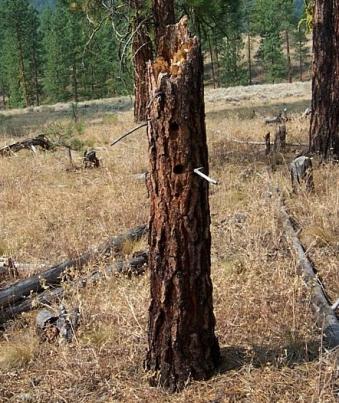Woodpeckers are considered keystone species because of their broad effects on other species. In nesting and foraging, woodpeckers create cavities and excavations that other species use, they aid in controlling forest insects, and they may help in dispersing spores of fungi that are agents of decay. Despite the importance of woodpeckers to forested ecosystems, few studies have examined metrics of woodpecker demography such as reproductive success or nest survival or have investigated the associations of habitat characteristics with these or related metrics.
In Washington, the White-headed Woodpecker (Dryobates albolarvatus) is listed as a species of concern because of its association with old-growth ponderosa pine forests. Although the White-headed Woodpecker has recently been documented inhabiting early- to mid-seral managed forests, information is limited regarding its reproductive success in these forests or in other areas of its range. To address this information gap, we evaluated temporal factors and habitat features associated with nest survival of the White-headed Woodpecker and two sympatric woodpeckers, the Hairy Woodpecker (D. villosus) and Northern Flicker (Colaptes auratus), breeding within managed ponderosa pine (Pinus ponderosa) forests in the eastern Cascade Range.
Our objectives were to (1) evaluate nest survival of each species in burned and unburned ponderosa pine forests with a recent history of management, (2) examine temporal and spatial factors that influence nest survival and compare these factors by species, and (3) document clutch size, egg success, fledging rates, and nest-initiation dates for each species.
Are White-headed Woodpeckers, a species typically associated with mature or old-growth ponderosa pine forests, able to successfully reproduce in stands with a history of timber management? Do habitat or spatial variables influence nest-survival of different woodpecker species equally? If not, how and why do they differ?
This project was completed in 2010 and the results published in the peer-reviewed journal The Condor in 2012. See project download below for a .pdf of that publication as well as links to related papers.
Status: Completed
04/01/2005 to 09/01/2010Project Manager
-
Jeff Kozma ,
Timber, Fish and Wildlife (TFW), Wildlife Biologist
509-865-5121 x6343




